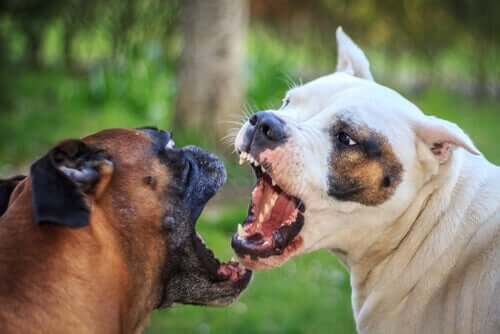It's Possible to Re-educate an Aggressive Dog

Aggression in dogs is a common problem, particularly in dogs that haven’t been socialized well as puppies or who have suffered some sort of trauma. However, it’s possible to re-educate an aggressive dog if you can identify the root cause and go to the right expert.
What’s aggression in dogs?
Aggression is the tendency to act or respond violently. This behavior can be seen in any animal species when they feel frightened or threatened. A small amount of aggression is natural up to point and is part of an animal’s ability to survive in the wild.
However, when aggression becomes part of a dog’s normal behavior and comes out in relatively normal situations, this is a problem.
Aggression is a form of disruptive behavior. Behavior is disruptive when it doesn’t allow the dog to live normally or causes problems for the people living with it. Other disruptive behaviors include poor social skills, fear, playing inappropriately, or not handling stress well.
An aggressive dog may attack themselves, other animals, strangers, or even the people they live with.

Types of aggression and causes
Aggression can be caused by different things depending on the individual dog. Identifying the type of aggression is a very important step and is the start of retraining an aggressive dog.
- Natural causes: pain, nervous system problems, or physiological problems
- Fear
- Hierarchy
- Avoidance: when a dog cannot escape or avoid a particular situation that it doesn’t like
- Territorial
- Maternal: defending their young
- Protecting resources
- Redirected aggression – this is when the aggression is directed at someone not involved in the original conflict
- Predatory: Dogs are instinctive hunters, and this instinct is evident in some of them
- Idiopathic: Where the aggression has no clear trigger. These are dogs that will jump at anything. Often the cause can be found with deeper investigation, but this isn’t a very common type of aggression.
- As a result of play
- Intraspecific: aimed at other dogs or dogs they live with
Stress is a very important factor in canine aggression. A dog that is very stressed as a result of lifestyle, lack of stimulation, or an inappropriate environment can become aggressive.

How to re-educate an aggressive dog?
As the word suggests, eliminating aggression requires “education”. Educating a dog is important so that they can enjoy all the possible situations they might find in their environment. This means that an aggressive dog needs an educator, not a trainer.
Canine re-education techniques can be dangerous if carried out by someone who isn’t an expert. It’s always best to go to a professional who will use the most appropriate technique for your dog.
There are many different techniques to re-educate an aggressive dog, but all of them should start with observation and communication with the dog. Here are a few examples:
- Stress Reduction Therapy. This requires more work than others, but it aims to reduce the dog’s anxiety in different situations. For example, using slow feed bowls at mealtimes, creating a richer environment, working to socialize with dogs and people, and increasing the time of walks where the dog can go and smell what they feel like, etc.
- Routine and desensitization. Prolonged but gradual exposure to the same stimulus will get your dog used to it.
- Conditioning. This can be used to positively condition the dog and either increase or reduce the behavior in question.
Finally, in order to eliminate bad behavior, it’s important to respond to your dog. For example, if you’re playing and your dog goes to bite, you need to stop playing. You could look for an alternative, such as using a chew toy. Furthermore, it’s important to look to control their impulses, whether they are to bite, eat, or play.
Aggression in dogs is a common problem, particularly in dogs that haven’t been socialized well as puppies or who have suffered some sort of trauma. However, it’s possible to re-educate an aggressive dog if you can identify the root cause and go to the right expert.
What’s aggression in dogs?
Aggression is the tendency to act or respond violently. This behavior can be seen in any animal species when they feel frightened or threatened. A small amount of aggression is natural up to point and is part of an animal’s ability to survive in the wild.
However, when aggression becomes part of a dog’s normal behavior and comes out in relatively normal situations, this is a problem.
Aggression is a form of disruptive behavior. Behavior is disruptive when it doesn’t allow the dog to live normally or causes problems for the people living with it. Other disruptive behaviors include poor social skills, fear, playing inappropriately, or not handling stress well.
An aggressive dog may attack themselves, other animals, strangers, or even the people they live with.

Types of aggression and causes
Aggression can be caused by different things depending on the individual dog. Identifying the type of aggression is a very important step and is the start of retraining an aggressive dog.
- Natural causes: pain, nervous system problems, or physiological problems
- Fear
- Hierarchy
- Avoidance: when a dog cannot escape or avoid a particular situation that it doesn’t like
- Territorial
- Maternal: defending their young
- Protecting resources
- Redirected aggression – this is when the aggression is directed at someone not involved in the original conflict
- Predatory: Dogs are instinctive hunters, and this instinct is evident in some of them
- Idiopathic: Where the aggression has no clear trigger. These are dogs that will jump at anything. Often the cause can be found with deeper investigation, but this isn’t a very common type of aggression.
- As a result of play
- Intraspecific: aimed at other dogs or dogs they live with
Stress is a very important factor in canine aggression. A dog that is very stressed as a result of lifestyle, lack of stimulation, or an inappropriate environment can become aggressive.

How to re-educate an aggressive dog?
As the word suggests, eliminating aggression requires “education”. Educating a dog is important so that they can enjoy all the possible situations they might find in their environment. This means that an aggressive dog needs an educator, not a trainer.
Canine re-education techniques can be dangerous if carried out by someone who isn’t an expert. It’s always best to go to a professional who will use the most appropriate technique for your dog.
There are many different techniques to re-educate an aggressive dog, but all of them should start with observation and communication with the dog. Here are a few examples:
- Stress Reduction Therapy. This requires more work than others, but it aims to reduce the dog’s anxiety in different situations. For example, using slow feed bowls at mealtimes, creating a richer environment, working to socialize with dogs and people, and increasing the time of walks where the dog can go and smell what they feel like, etc.
- Routine and desensitization. Prolonged but gradual exposure to the same stimulus will get your dog used to it.
- Conditioning. This can be used to positively condition the dog and either increase or reduce the behavior in question.
Finally, in order to eliminate bad behavior, it’s important to respond to your dog. For example, if you’re playing and your dog goes to bite, you need to stop playing. You could look for an alternative, such as using a chew toy. Furthermore, it’s important to look to control their impulses, whether they are to bite, eat, or play.
All cited sources were thoroughly reviewed by our team to ensure their quality, reliability, currency, and validity. The bibliography of this article was considered reliable and of academic or scientific accuracy.
- Schwartz, C. El comportamiento del perro. L’Hospitalet, Editorial Hispano Europea, 2005
- X. Manteca J, A. Sarde. Diagnóstico de los diferentes tipos de agresividad del perro dirigida hacia las personas. Clínica veterinaria de pequeños animales. Volumen 12, número 4. Octubre/ Diciembre 1992.
- Portalveterinaria. Etiología, diagnóstico y tratamiento de la agresividad canina.
- Habla con ellos. Educación y adiestramiento canino.
This text is provided for informational purposes only and does not replace consultation with a professional. If in doubt, consult your specialist.








